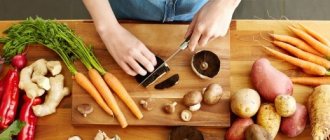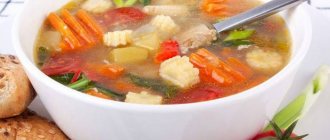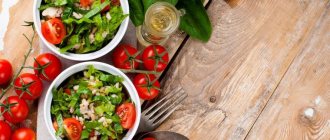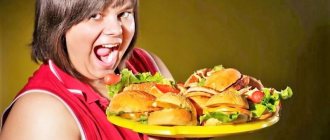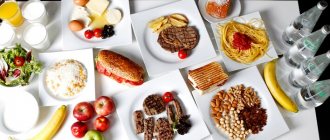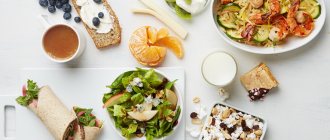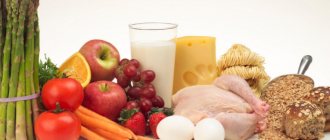A diet is considered best when acquired eating habits can remain with a person for life. Most dietary restrictions do not involve such practices and are short-term in nature or even do not bring results. One of the reasons for stagnation in weight loss is the incompatibility of the foods consumed. Interesting? Let's study the topic together!
The principles of separate nutrition have long been successfully used for losing weight and cleansing the body. According to this technique, eating foods that are compatible with each other facilitates digestion and improves absorption.
The author of the method, Herbert Shelton, suggested that nature does not provide for the need for the separation of products in mammals. In wildlife, it is unlikely that there will be a predator that will eat game with carbohydrate products.
The approach seems complicated at first. This article will help you:
- master the principles of separate nutrition for weight loss;
- learn about the compatibility of products when eating separately using tables;
- master suitable recipes for separate meals by adding to the cookbook.
Bodymaster.ru recommends Training Plans:
The main principle of separate nutrition is to separate proteins and carbohydrates between meals, which require certain conditions for digestion. When foods containing both of these substances are consumed simultaneously, both acid and alkali are released in the body. The second enzymes neutralize the first. This leads to the fact that food is not completely digested and is deposited in the colon. To avoid this, take a break of at least three hours between taking carbohydrates and proteins.
Dishes with a complex composition load the gastrointestinal tract, causing malaise. Due to this, food is digested more slowly and is partially not absorbed. The result is fat accumulation, fermentation and rotting. Therefore, it is first recommended to eat a portion of proteins, and after 3 hours, when the body has rested, complex (slow) carbohydrates to taste.
What cannot be combined with each other when eating separately
Separate nutrition for weight loss divides all products into three groups:
Starchy
The product group includes:
- main sources of carbohydrates (cereals, potatoes, bread, pasta);
- flour products;
- fruits and dried fruits;
- sweeteners (sugar, honey, maple syrup).
Neutral
Products include:
- root vegetables (except potatoes), green and leafy vegetables;
- oils and fats.
Protein
Products presented:
- meat, fish and seafood;
- milk products;
- vegetable proteins (tofu, soybeans).
Starchy and protein foods are incompatible with each other. In the diet, they should be consumed separately or combined with neutral ones. When planning meals, you should also take into account that it takes different periods of time to digest and assimilate foods from different groups.
Simple carbohydrates are digested in 1.5-2 hours, complex carbohydrates – in 3-4 hours, digestion of protein foods takes the longest – 8-10 hours. Therefore, you need to consume foods so that they do not interfere with each other. Every day you should follow the sequence: in the morning you eat simple carbohydrates, then complex carbohydrates and in the evening you eat protein foods.
7 rules of separate nutrition for weight loss
Shelton formed the rules for separate nutrition for weight loss, describing groups of incompatible foods that he recommends for consumption in different time frames or even on different days:
- Protein + protein: protein products are consumed separately, despite the similarity of the macronutrient. The body may process types of protein differently. It is not recommended to combine cottage cheese and meat, eggs and meat, meat and cheese, etc.
- Protein + carbohydrates: eggs, dairy products, meat, poultry, seafood and nuts cannot be combined with cereals, potatoes, and flour products. This combination is most often present in the diet of every person.
- Protein + acids: fish, meat and poultry are not served with tomatoes or in a lemon juice marinade.
- Protein + fats: from the point of view of the usual diet, it looks like this: during the preparation of meat products, you cannot add vegetable and animal fats (oils), or season cheese and egg salads.
- Acids + starch: Starch-rich carbohydrates and sour vegetables and fruits should not be placed on the plate. Potatoes, baked goods, and legumes do not go well with apples, citrus fruits, tomatoes, kiwis, etc.
- Starch + sugar: example - pancakes with raspberry jam. This combination should not be found in the diet, just like sweet cereals, bread with confiture, etc.
- Single products: milk, melon and watermelon do not have compatibility conditions. They should be consumed separately from any dish: coffee without milk, buckwheat with milk is prohibited, as are fruit salads with melon or watermelon.
It is important to correctly calculate the caloric content of the diet when losing weight in order to form portions in accordance with the body’s need for energy.
Techniques
Time is fleeting, and it is impossible to pause, control, and, moreover, return it. But you have the power to control it, to distribute every minute of life so as to feel its fullness and richness.
1. Notepad. It will be so difficult to come up with a daily routine that suits you. First of all, just keep a small notebook where you will write down all the desires, goals, and things that need to be accomplished. It is important that he is always with you, you never know when he will enlighten you. Also brainstorm, writing down every thought and idea that comes to mind.
2. Analysis. When the general plan is complete and ready, try to analyze it in order to discard the unnecessary, or, conversely, combine some tasks based on similarity. For example, if you have to walk your dog in the morning and evening, then it is quite possible to do shopping at this moment if the necessary supermarket is located near your house. This way you will save not only time, but also energy. Also, do not be afraid to delegate some tasks; if you do not have time to cope with everything, ask your family or those with whom you live to help you.
3. List. Now write a list of your responsibilities and needs. Then review each item and ask yourself a simple question: “What should I do to...?” For example: “What do I need to do so that my child comes to school on time and studies well?”, “What do I need to do before work?”, “What should I prepare before bed so as not to waste extra time in the morning?” And so on.
4. Diary. Then take a diary, or, if you prefer, an electronic schedule, and try to distribute all your tasks over time. Try to make a draft first, because the first time it is unlikely that you will be able to take into account all the nuances and create a suitable plan.
5. Action. And the last step is strict adherence to the routine. It is clear that all sorts of force majeure situations happen that cannot be predicted, but try not to do yourself any favors, respect the boundaries, so over time you will get used to it, and you will not have to make additional efforts; you will already follow the regime at the subconscious level.
Advantages and disadvantages of the system
Fans of separate nutrition talk about the advantages that the technique provides:
- cleansing the digestive system and gastrointestinal tract;
- eliminating bad breath;
- removal of toxins;
- relief from constipation and dysbacteriosis;
- restoring balance in the functioning of internal organs;
- getting rid of excess weight.
Separate meals are not just advantages. You must understand that such a radical restructuring of the body will not remain without consequences. Nutritionists say that separate meals force the body to forget how to digest mixed food, so when you switch to your usual diet, prepare for problems with the gastrointestinal tract.
It is also important to consider that separate meals for weight loss are fundamentally different from traditional ideas about food. It is difficult to switch to a new food system from a psychological point of view: a person is so accustomed to mixed food that its separate consumption will leave a constant feeling of dissatisfaction, which leads to overeating. Eating will turn into a mechanical replenishment of energy reserves and will not bring pleasure.
What is fractional nutrition?
Before we talk about a sample menu for fractional meals for weight loss, we’ll briefly tell you what this system actually is and why it’s good. For example, this type is used in the “1200 calorie” diet for quick weight loss.
We won't bore you with complicated terms. It's simple: the split-meal menu should consist of about five to six meals. That is, you need to eat approximately every three to four hours (at night, of course, does not count). Portions should be small - this is also very important. Ideally, it will be equal to the volume of the glass (this is approximately 250 grams).
Daily calorie intake should gradually decrease to 1200-1600 kcal. The ratio of proteins, fats, carbohydrates, vitamins and microelements (especially fiber) must also be observed quite strictly. But it will be difficult only at first - then it will become much easier to control the situation. To improve the result, you can also consider separate nutrition.
The effect of this regime is obvious: metabolism, the state of the gastrointestinal tract and liver are noticeably improved, the consequences of poor nutrition are eliminated - diarrhea, nausea, heaviness in the abdomen, bloating, cramps and colic. And, of course, excess weight comes off. If you strictly follow the fractional meal menu for a month, you can part with 5-7 kilograms. The results after six months of the “diet” are even more stunning - up to 20 kilograms!
We advise you to read: menu for proper nutrition for every day
Bodymaster.ru recommends Fitness Trainers:
In the left column you see product groups that are compared with similar names above, and the corresponding designations are written inside:
1 – very bad; 2 – bad; 3 – average; 4 – good; 5 – excellent.
Compatibility of individual product categories according to G. Shelton
The table corresponds to the basics of separate nutrition.
VII. Creating a daily routine for a teenager (school student)
1. You don’t need to start creating a daily routine right away. Initially, we should carry out “field” work - let’s go on reconnaissance. As in the case of drawing up an adult daily routine, some time should be used to measure the time that you spend on the most ordinary things: how long it takes to get to an educational institution, how long do sambo classes, drawing, music school, performing "homework". If the student has personally drawn up his own daily routine, then it is better for his father or mother to control such developments. Parents, remember: children at their specific age should rest longer than adults! In the child’s daily routine, the last postulate must be taken into account
2. School education is structured taking into account pedagogical methods, developments in the field of child psychology, and the characteristics of the age groups to which the student belongs. The number of classes and electives is not accidental; it provides the optimal load on the child. At the same time, his rest should be planned as follows: the student is entitled to 1.5 hours of rest immediately after returning from school and the same amount immediately after completing his homework. It is recommended to spend some part of this time outside
3. The majority of a student’s rest time cannot be given over to the TV box or sitting at the computer unrelated to doing homework. An excellent solution is to enroll your child in a sports section or hobby group. You can also entrust him with performing any duties around the house (cleaning, cooking).
4. Know how to motivate your child to follow the daily routine without arguing. Don't know how? Look for approaches! In advanced cases, it makes sense to talk with a school psychologist
5. If your child is only attending primary school, do not forget to include time for naps during the day in his daily routine. But high school students may have concessions in matters of strictly following the daily routine. They may go to bed a little later than their younger brothers and sisters. They should also have the opportunity to personally adjust their daily routine. It is best for schoolchildren of all ages to do homework from four to six in the evening. And reading books and textbooks is best done in the evening hours.
6. Here is an example of a pediatrician-approved daily routine for a 3rd grade student.
Stage 1. 07:01. We wake up.
Stage 2. 07:01-07:30. Easy charging, hygiene procedures.
Stage 3. 07:31-07:46. Morning meal (breakfast).
Stage 4. 08:31-13:06. Studies.
Stage 5. 13:31-14:01. Daily meal No. 1 (lunch).
Stage 6. 14:01-15:46. Various outdoor games, walks outside.
Stage 7. 15:46-16:01. Daily meal No. 2 (afternoon snack).
Stage 8. 16:01-18:01. Doing homework.
Stage 9. 18:01-19:01. Rest, some free time.
Stage 10. 19:01-19:31. Evening meal (dinner).
Stage 11. 19:31-20:01. Rest, you can combine it with housework.
Stage 12. 20:01-20:31. Evening walk in the fresh air.
Stage 13. 20:31-21:01. Getting ready to sleep.
Stage 14. 21:01. Time to go to bed.
Prohibited foods for separate meals
The following should be excluded from the diet:
- sugar and products with added ingredients;
- soda, packaged drinks;
- canned food, preserves;
- food ingredients (sauces, mayonnaise), refined oil, margarine and spread;
- sausages, smoked products;
- salted, dried fish.
Such food is, in principle, harmful to health and figure, slowing down weight loss.
Menu for separate meals for a week
Having chosen separate meals for weight loss, an individual menu is created for the week or a ready-made option is used - the table includes 5 meals with an interval of 3 hours.
Carbohydrates can be taken at any time, but it is recommended to “load” with a macronutrient in the morning or before training to provide the body with the energy it needs.
| Day of the week | Breakfast | Lunch | Dinner | Afternoon snack | Dinner |
| Monday | Omelet + broccoli + tea without sugar | Green apple | Lenten soup with potatoes and carrots | Skim cheese | Boiled fish + asparagus/green beans |
| Tuesday | Steamed buckwheat + cucumber and Chinese cabbage salad + tea without sugar | Low-fat cottage cheese + natural yogurt without additives | Lenten vegetable soup | A piece of hard cheese | Braised chicken liver + green salad |
| Wednesday | Oatmeal with water + coffee without sugar | Crispbread + slice of cheese | Vegetable stew of green beans, onions, carrots stewed in its own juice | Melon | Steamed salmon + cucumber salad |
| Thursday | Oatmeal in water with dried apricots + tea without sugar | Green apple | Spinach puree soup + boiled chicken fillet | Banana + herbal tea without sugar | Boiled veal + seaweed |
| Friday | Omelet + spinach + tea without sugar | Grapefruit | Steamed broccoli + steamed turkey fillet | Low-fat cottage cheese + dried apricots | Baked pumpkin with prunes |
| Saturday | Multigrain porridge with water + tea with herbs | A portion of nuts (to taste) | Pumpkin puree soup with water | Watermelon | Boiled green peas + steamed turkey fillet |
| Sunday | It is recommended to spend a fasting day on your favorite product (for example, 1% kefir, oatmeal, apples or buckwheat) | ||||
Pros and cons of the “Minus 60” diet
A pleasant thing is that in the first half of the day you can eat your usual food. For example, a cake, a sandwich, fried potatoes, pasta with a fried cutlet. Of course, you will have to reduce the portions. But this will reduce the risk of failure.
A significant disadvantage is the slow weight loss. But if you look from the other side, losing weight quickly is harmful to the body.
There are a lot of supporters of the “Minus 60” system; in 10 years it has not lost its relevance. Millions of women and men have regained their slim figure. The diet does not require restrictions, which is what attracts people with excess body weight.
Products for the week
When creating a menu for separate meals for weight loss, you can rely on the list below, which will help you form a food basket:
- white fish, red fish (in small quantities);
- poultry (chicken fillet, turkey);
- eggs;
- dairy products, cheeses;
- fruits: green apples and pears, oranges and grapefruits;
- vegetables: cucumbers, cabbage, broccoli, green beans, greens, potatoes, pumpkin, tomatoes, carrots;
- unrefined vegetable oil;
- cereals: oatmeal, buckwheat, borax rice;
- dried fruits and nuts.
The basis of time management is goal setting
A person has values, fundamental life positions and goals. A person's success depends on how aligned his goals and values are.
All stress, conflicts, and uncertainties arise when your actions contradict your internal values. What steps are you taking to make your actions even more consistent with your beliefs?!
To achieve results, you need to have a clear idea of what you want to achieve and in what direction to develop. A road without a goal is a path to nowhere. When you do something, constantly ask yourself for what purpose you are doing it. You can only get closer to your goal when you know what your goal is.
Make a to-do list of what you did during the month, week, day. There will be fifty cases. But only 3-5 of them provide 80% success. 10 skills can be well developed, of which 2-3 types of activities are better than other people.
View your time as an investment in the 2-3 activities that will contribute most to your future. By investing 80% of your time in this way, you will get closer to your goal every day.
Constantly ask yourself the question of how consistent the achievement of your plans at the moment is with what you are doing now. What is the most valuable investment of time? The correct answer is to spend time on what is most important to achieve your goal at that moment.
Now go back to your daily to-do list and rank all tasks into categories A, B, C, D, E. The importance of each task is determined by the level of consequences for you, from the results of its implementation or failure to complete it:
- Category “A” tasks
- Category “B” tasks
- Category “B” tasks
- Problems of category "D"
- Category “D” tasks
is something you must do that has serious consequences depending on whether you solve these problems or not. Doing it will bring you great benefit, not doing it will be against you. Category “A” cases provide 80% of the result.
is something that should be done, but has moderate consequences if done or not done. In case of non-compliance, inconveniences may arise, but nothing serious will happen. Never take on tasks of category “B” if there are tasks of category “A” that have not been completed.
- these are things that would be good to do. These are easy and pleasant things - sitting with friends, chatting on social networks, drinking a cup of coffee... These are things that do not have any impact on your future. Eliminate all category “B” tasks from your workday to leave more time for completing “A” and “B” tasks.
- this is everything that can be entrusted to others. Delegate everything that does not have consequences for the future in order to free up time for solving problems of categories “A” and “B”.
- unimportant tasks that can be abandoned without any damage or discomfort.
You can take control of your time if you give up tasks that are not important or of low value to you.
When there are several “A” category tasks in your plan for the coming day, then rank them according to the level of consequences at A1, A2, A3 and start completing them from A1. This is the most important time management skill you can master.
Results are obtained by regularly taking steps leading to the intended goal. Break down large tasks into small tasks, this will make them easier to complete and easier to control completion at each stage.
Diet for weight loss for 90 days: menu
A 90-day weight loss system is a diet based on separate meals with a special eating order.
Menu by day of the week
Each day is characterized by eating a certain type of food:
- protein;
- starch;
- carbohydrate;
- fruit.
There is also a fasting day, when only plain water is consumed.
- Protein day - eat foods rich in protein: lean meats, poultry fillets, fish and seafood, legumes, dairy products.
- Starchy day - the menu contains only unprocessed cereals, whole grain bread, starchy vegetables (pumpkin, carrots, potatoes, cauliflower). You can drink tea without sugar.
- Carbohydrate day - the diet includes unprocessed cereals, durum pasta, vegetables, baked goods made from durum wheat without added sugar. This day will be remembered for the opportunity to eat 15-20 g of dark chocolate.
- Fruit (vitamin) day - during the day you can eat fruits, drink natural freshly squeezed juices, nuts in small quantities (due to the high calorie content of the product).
- The fasting day is the most difficult physically and psychologically. You need to show perseverance and self-control to achieve your goal. It is recommended to choose a comfortable product as part of your diet.
A prerequisite is compliance with the drinking regime. Do not limit your consumption of pure water. Then, to maintain the diet for 90 days, the cycles of separate meals are repeated in a circle. At the end of the period, the diet changes to normal.
Schedule
To make it easier to create your daily routine, I want to give an example that you can rely on and build on. Adjust your time individually, depending on your needs and responsibilities.
- 7:00 – wake up. Get up as soon as the alarm clock rings, otherwise you risk falling asleep again.
- 7:10 – airing the room and bathing procedures.
- 7:30 – exercise.
- 7:45 – breakfast and bed cleaning.
- 8:20 – drive to work. It is advisable to have time to walk at least a little, it is good for your internal organs and, in general, will help you feel good.
- 9:00 – perform work duties. Try to arrive 10 minutes early to give yourself time to collect your thoughts. Take short rest breaks before lunch. It will be great if you use the Pomodoro method described here. Also take care of your eyes and back, do exercises and warm-ups, especially if you have a sedentary job, also at the computer.
- 14:00 – lunch.
- 15:00 – begin further duties.
- 18:00 – it is advisable to take a walk on the way home; fresh air will contribute to sound and full sleep, oxygen saturation will allow you to replenish your energy reserves for the evening.
- 18:30 – shopping for necessary groceries, walking with your pet, and other worries.
- 19:30 – dinner. It is advisable to exclude fatty fried foods, sweets and spicy, salty foods.
- 20:00 – time for yourself. Do your favorite hobby, read a book, watch a movie, etc.
- 21:00 – bath procedures and making plans for the next day.
- 22:00 – listening to calm relaxing music, sleep. It is recommended not to go to bed later than 00:00, otherwise you will disrupt the production of hormones that protect us from stress, and this can lead to insomnia and depression.
Recipes
All recipes for separate meals are easy to prepare and will not take much time.
Lenten vegetable soup
Recipe No. 1
Cooking method:
- Peel the vegetables, rinse, cut into cubes. Boil all ingredients until tender.
*Can be served with rye breadcrumbs.
Ingredients: - Potatoes - 210 g; — Carrots – 60 g; — Onion – 40 g; — Fresh green peas – 50 g; — Parsley – 10 g; — Water – 1 l.
Steamed veal with carrots in a slow cooker
Recipe No. 2
Cooking method:
- Wash the veal and cut into slices.
- Wash the carrots, remove skins and stems.
- Place the ingredients in the multicooker bowl; cooking time in the “Steam” mode is 20 minutes.
- Chop the parsley and decorate the finished dish.
Ingredients: - Veal - 500 g; — Carrots – 150 g; — Parsley – 15 g.
Baked pumpkin with prunes
Recipe No. 3
Cooking method:
- Pour boiling water over pitted prunes and leave for an hour.
- Wash the pumpkin, peel it, cut into slices or cubes.
- Grease a baking sheet with a drop of vegetable oil and lay out the ingredients.
- Place in an oven preheated to 180 degrees for 20 minutes.
*On a carbohydrate day, you can serve it with honey.
Ingredients: - Pumpkin - 500 g; — Prunes – 100 g.
Vegetable pea soup
What to cook for lunch? This delicate pea soup with vegetables will definitely hit the spot. It will require the following components:
- Peas - half a glass.
- Carrot – 1 piece.
- Bell pepper – 1 piece.
- Onion – 1 piece.
- Potatoes – 3 pieces.
- Greens - to taste.
- Oil – 2 tablespoons.
- Salt - to taste.
- Soak the peas for five to seven hours. If you use frozen green peas, there is no need to soak them.
- Boil one and a half liters of water, add peas, salt to taste, and cook.
- Finely chop the onion and carrot, fry in two tablespoons of vegetable oil.
- Place the roast in a saucepan and mix well.
- Cut the potatoes into small cubes and add them to the soup being prepared.
- We also cut the sweet pepper into small pieces and add it to the pan with the other ingredients.
- Finely chop the greens and add them to the soup five minutes before they are ready. Bon appetit.
https://youtu.be/ma3LPGWWqS4
Physical activity with separate meals
Often, after short-term diets, lost kilograms return with weight gain. By calculating the daily calorie requirement, as well as adding physical activity to the separate nutrition method, you can maintain the stability of losing extra pounds and not be afraid of weight gain.
The main thing is to choose the most suitable option for physical activity in accordance with the capabilities and characteristics of the body.
Stages of the training process
- Dynamic warm-up of the whole body: muscles, tendons.
- Light cardio workout for 5 – 10 minutes.
- Power training.
- Cardio load.
Strength training will help work out every muscle group, maintaining their tone, and cardio sessions saturate the organs with oxygen, train the heart muscle and help expend a large amount of energy, stimulating fat burning processes.
Results after the Dukan diet
Each phase of the diet produces results that are different from the previous one. For example, at the “Attack” stage, weight comes off quickly, you can lose 5-7 kg, but mostly water goes away. From the second phase, when the body has started the fat burning process, volumes begin to decrease due to the burning of subcutaneous fat. Here you need to take into account the individual characteristics of the body, and how much weight you lose depends only on you. The “Alternation” stage will last as long as you need.
Remember! To lose weight without harm to the body, you need to lose no more than 1 kg per week.
During this stage you can lose weight from 10 to 30 kg on average. These are real indicators, of course, with an excess weight of 50 kg, such a result may not be achieved, perhaps the reason will be hormonal and metabolic disorders. Passing the “Stabilization” stage implies maintaining the result, even when returning to your usual eating behavior. But this doesn’t always work for everyone. Therefore, adhere to all the rules for quitting the diet on an ongoing basis, then you won’t be afraid of excess weight.
https://youtu.be/bZew1BvZDxg
